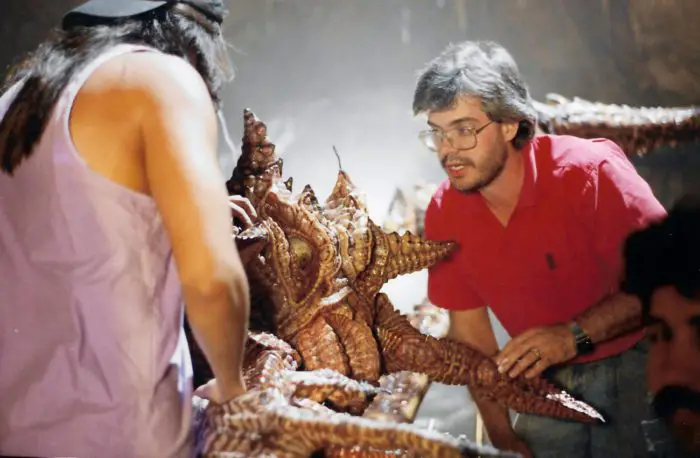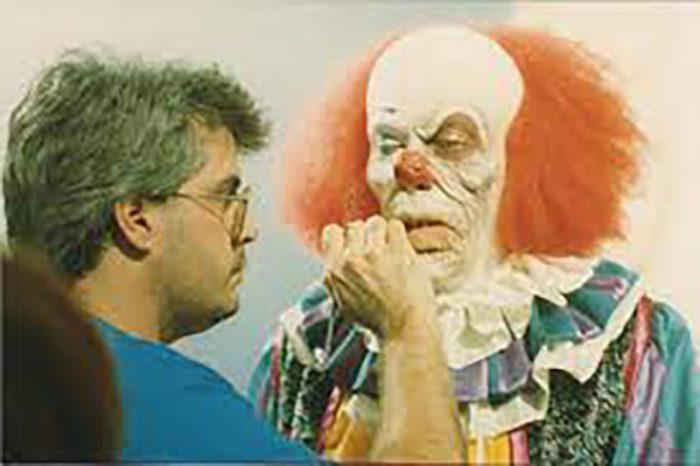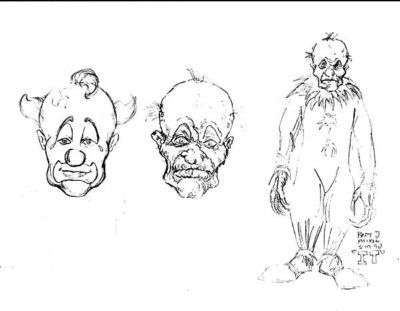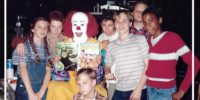With credits like A Nightmare on Elm Street 2: Freddy’s Revenge, Fright Night 2, RoboCop, and Planet of the Apes, it’s safe to say special effects makeup artist Bart Mixon is a veteran in the industry. One of his most notable projects, the 1990 IT miniseries, is now the subject of a documentary titled Pennywise: The Story of IT. Directed by John Campopiano and Chris Griffiths, the doc explores the legacy of the show as well as the cultural impact that Pennywise has had on a generation of fans. A big reason for the impact is Tim Curry’s terrifying look, which Bart helped transform. We spoke to Bart in depth below about his experience on that series and many more.
Pennywise: The Story of IT is now playing exclusively on Screambox. Thirty-day free trials are available to new subscribers.
Chris Miller: First off, how did you get the job on IT?
Bart Mixon: I had a working relationship with Fantasy II Film Effects, Gene Warren’s company, we did Fright Night 2 together. His company normally did opticals and miniatures and he wanted to be able to offer makeup effects as well to compete with shops like Boss Films. Boss had done the first Fright Night, they did both the makeup and visual effects under the one roof. He was just trying to replicate that model. We got along great with Tommy on Fright Night 2, so when IT came around a couple of years later, it seemed like a natural fit because he was already comfortable working with Gene and I.

CM: Where did you even start when it comes to Tim Curry’s makeup for IT? What took the longest time when it came to his makeup effects?
Bart Mixon: In designing Tim’s makeup, when I first read the script, I started doing clown research and started sketching clowns. Makeup like the Pennywise makeup is pretty performer driven, so I quickly found that just drawing clowns didn’t really make a difference, I had to draw it on the actors. Once they finally cast Tim in the role, I got a headshot of him and started drawing on it. This was before Photoshop in 1990. I did a dozen or more 2D sketches and then would submit those to Tommy to get his feedback. He picked three he liked and then we did a clay sketch, where we took a life cast of Tim Curry and plaster heads, and then I took water-based clays, which are faster to sculpt with, and did the three favorite designs. I did paint on them, just a rough suggestion, and put wigs on them, and sent them back to Tommy. Tommy was in Vancouver at this point prepping, and I was in Burbank. Fantasy II was located there. Tommy picked one, and I had to resculpt that with prosthetic makeup. Originally it was five pieces, the head, nose, cheekbones, and chin. We tested it with and without the chin and cheek pieces. Tim wasn’t keen on wearing more makeup than he had to, so they picked the lighter look and then did one more text honing in on the paint scheme. We shot for eight weeks and we made him up maybe once or twice a week, which constituted me flying from Vancouver a lot. Other than that, Tim’s makeup was pretty simple and straightforward.
In terms of what I worked on, the spider…that was most involved. The werewolf had a lot of hair. Everything went pretty smoothly; nothing was really problematic. The spider was one of the first things we started on and the last thing we delivered and shot.
CM: When you were creating this look for him, did he have any input?
Bart Mixon: Tim didn’t have any input in the sculpting phase. Once we actually did the application, he did, though. The first test we did was just the head and nose. Tim had some specific thoughts on those. I think there are some photos of this in the documentary. It was even more minimal than was in the final. The lips were smaller than what they were now and probably just some eyeliner and eyebrows. It was pretty minor. The one Tommy had approved had a bigger red smile and big blue eyeshadow that was trying to suggest eye sockets and skull. The second test we did, we added the cheekbones and chin. The film tested both of them, and then we did a third test where the blue eye shadow was really reduced to just the lids and then got smaller and even more triangular.
The battery acid look—when that was sculpted and created, that was done under the assumption that we were going to use the cheekbones and chin in the regular look and also the big blue eye shadow. That’s why on the acid disfigured side, you will notice he has the big arched brow. That’s because he was going to mirror the other normal side. By the time we made the changes and the normal Pennywise makeup was decided, there wasn’t time to resculpt that one. If you look, it also has cheekbones and a chin. So it’s a little distorted, but it’s easy to get away with it because of the battery acid.

CM: Was there any part of Tim’s makeup effects that proved particularly problematic during takes?
Bart Mixon: Heat is always our enemy. Some of the locations were pretty warm. We use a material called pax paint that Dick Smith developed for Tootsie. It became an industry standard after the early ’80s. It’s basically an acrylic glue and then liquid acrylic paint. When you paint it on, sweat doesn’t come through because it’s basically a plastic layer. I wanted a pure white, almost like a cartoon, so I used the pax paint and did several layers on his skin. When he did sweat, it didn’t have anywhere to go, so it just raised bubbles under this layer of paint. If you tried to wipe it, it would just take a layer of the paint off, which I think I found out the hard way on Texas Chainsaw 2 using the same material. I think it probably took us a few tries to find eye makeup that stayed on. Initially, I tried grease paint and that seemed to crease a lot and eventually sweat off, so I think we ended up using Supracolor, which is another Krylon makeup that is just heavier. Typical problems, maintaining lips and eyes. I think there are a few shots where there are some cutaways, that must have been a hot day with some bubbles in the makeup. Tim was very respectful of the makeup and knew how to take care of it. He was mindful of it and did his part, like a good actor should.
CM: When you heard there was going to be an IT documentary, what were you most excited to get to talk about?
Bart Mixon: I had already worked on the Fright Night documentary with the directors. They had also interviewed me for RoboCop. During one of those sessions, I mentioned I had a huge notebook of IT stuff and two hours of home videos from the IT set. They were interested in seeing that. I think I was probably just happy that this footage from 1990 was finally getting to be seen somewhere. I was a little disappointed that there was no special features on the IT DVD when it came out in 1990. I thought I had missed my chance to share that material. So I was really excited when John and Chris were interested.
My one regret: I didn’t realize how little I shot in the trailer. I wish we would have set up the camera of Tim in the chair and done a whole time-lapse sequence. I wish I would have documented his application as well as Al Marsh’s and some of the other characters. At the time, you don’t know what will be big and what won’t. I never dreamed that 30 years later, I would still be talking about it. At least I documented the shop build as well as I did. Not long ago some photos resurfaced of me applying the makeup, which I had never seen until recently. I didn’t even remember someone taking photos behind me, so at least those exist.
CM: Is there something about your work on IT that readers might not know?
Bart Mixon: The one creature thing we didn’t do is the fortune cookie scene. The physical effects guys up in Canada, I believe John Thomas was the head guy, they wanted to have a little bit of fun. Since that was such a small thing in itself and had to be rigged into the table, I suggested they did it. Otherwise, all the creature effects came under my supervision.

CM: You have worked on some very iconic projects including A Nightmare on Elm Street 2: Freddy’s Revenge and The Texas Chainsaw Massacre 2. How has your industry changed since when you first got started?
Bart Mixon: In the ’70s and early ’80s, there was definitely a sense that Rick Baker, Stan Winston were the rockstars. Initially, producers didn’t know how any of this was done. By the time I came in, it was starting to get more commonplace. By Fright Night 2, Tommy had a lot of art direction background, so we were certainly working with him more closely. I made suggestions in IT that he didn’t use, which is fine. We were there for him to realize his vision. Some ideas stick and some don’t. Now the industry is almost like a vender situation. A lot of shows will hire a design company to design the character, instead of the makeup artist. And then they will just shop the design around. In the ’70s and ’80s, you could see a Dick Smith movie and Stan Winston movie or a Rick Baker movie and you could tell who worked on it. You could see their style in their work. Greg Cannon’s stuff had a very certain look. Now it’s a little more homogeneous, just because a lot of the crews go back and forth and the same guy might be designing all these shows.
When I did The Cat in the Hat with Steve Johnson, Rick Baker had started it. Then he had some issues with the production, so he left. Then they took his design to three shops and whoever did best, they got the job. I think it’s more of that now. It’s lost some of the mystique and I kinda feel like they think anybody can do it. I think because of the digital age, you don’t have to commit to anything until after the movie is done. You can redesign the whole creature now. Whereas before, like the spider on IT, you had to commit 12 weeks before to a design. I think a lot of these guys think that because they can do this with digital effects, they can do it with makeup effects also.
I do more application now than I do building the stuff. I haven’t had my shop for a few decades now. I’m happy to work for my friends, applying their cool makeup. I don’t think I could take it if I had to be making 11th-hour changes on things.
CM: You worked on A Nightmare on Elm Street 2: Freddy’s Revenge and A Nightmare on Elm Street 4: The Dream Master in the ’80s, then the 2010 remake, A Nightmare on Elm Street. What was it like revisiting that character 25 years later?
Bart Mixon: It was cool. On Nightmare on Elm Street Part 2, I’m not sure why Mark Shostrom chose to do the transformation stuff, but I worked with him and Kevin Yagher. At that point, Freddy had already been designed, so Mark wanted the transformations because he thought it would be cooler. Had he done the normal Freddy makeup, he would have done the next five sequels. So, it was nice on the remake to actually be working on Freddy himself. I think Andrew Clement did a nice, updated, fresh take. I’m glad it just wasn’t a regurgitation of what had already been done on Robert England, that I thought looked great, especially for Kevin Yagher’s redesign for Part II. I thought what we did for Jackie Earle Haley, looked like a real burn victim. He got changed some in post-production, but I thought Jackie was a good choice. I don’t know how apparent it is in the movie, but I like that Jackie isn’t an imposing figure in real life. When he was terrorizing the kids, he was a lot bigger than them. But now that they have grown up and are in high school, they were bigger than him. I thought that was an interesting dynamic. Overall, I was happy with our makeup.

CM: You worked on Thor: Love and Thunder which is out now. Are you allowed to say what you did on that film?
Bart Mixon: I worked on it a little bit. Initially, I went over at the beginning of production to Australia; a friend of mine, Chris Nelson, has done Nebula since Guardians 2. He and another makeup artist would do it together. When it was time to go to Australia, they were on another project, so they needed another assistant for Chris to help. We go back to a show called Danger Island, which was another Tommy project. So I was over there for the duration of Guardians helping with Nebula. That was the first phase. Then a year and a half later, I was on a break from Guardians 3 and they were doing Thor reshoots. The team that was put together to do reshoots for Christian Bale, they weren’t available for this wave of reshoots. So a few of us ended up doing Bale. When he goes to the gateway to eternity, pretty much all that scene that doesn’t have his daughter, that was all new stuff we did. Pretty much every scene, when he has Thor tied up, we worked on those. They did quite a bit of him in the two days he worked. We did a few shots on the moon. So just random stuff throughout the film. He couldn’t shave his head like he did originally in Australia. So we had to put a bald cap on him. Fun stuff.



